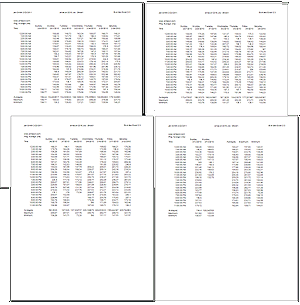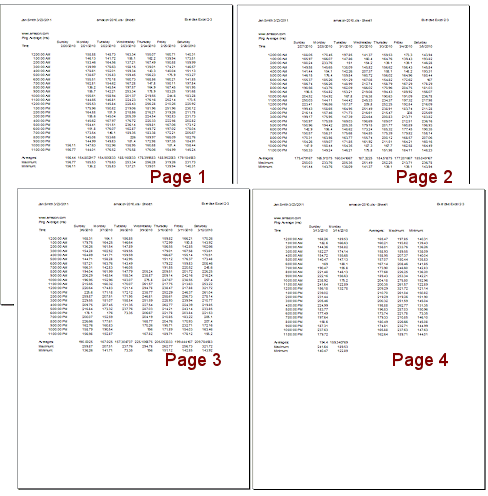Jan's Working with Numbers
Excel Basics: Exercise Excel 2-3
You will edit an existing sheet of data from an experiment on ping times. Only functional formatting for this one. It won't be 'pretty' but it will be informative.

Exercise Excel 2-3: Pings - Average, Max, Min
| What you will do: | Edit an existing spreadsheet AutoFit columns Set column widths AutoFill data Use Page Break Preview Create formulas using Average, Max, and Min Autofill formulas |
Start with: amazon-2010.xls from your resource files
The editors of the newsletter Computers Today want to write an article about what things influence how fast your Internet connection is. To measure Internet speed they timed a signal that they sent to certain web sites. Such a signal is called a ping. The chosen sites have been pinged every hour every day for weeks. The editors plan to analyze the data to show people how the time of day, the day of the week, and the kind of web site affect how fast your connection is to a site on the Internet.
This exercise will work with a spreadsheet for one of the
sites tested.
[The data are quite real but were recorded for a
school science fair project in 1998 rather than for our imaginary newsletter
editors. Speeds have no doubt changed since then!]
- Open: Open the file amazon-2010.xls from your resource
files or download it now.
Sheet1 shows some of the data collected on the speed of Internet connection to Amazon, www.amazon.com. (A real site) The data extends off screen to the right to Column Y.
-
 Save as ex2-3-amazon-Lastname-Firstname.xlsx in the excel project2 folder
of your Class disk.
Save as ex2-3-amazon-Lastname-Firstname.xlsx in the excel project2 folder
of your Class disk.
(Be sure to change the file type Excel Worksheet. Just typing in the file's extension does not automatically change the file type.) -
AutoFit: Widen Column A with AutoFit so you can read the times in those cells.
The times are not actually correct. Each one should be at 38 minutes after the hour instead of exactly on the hour.
- AutoFill: Rewrite the series of times by editing the first
time to 12:38:00 AM and using AutoFill to complete the column.
-
AutoFill: In cell C3 type Sunday . Then drag the fill handle along the row until you reach Column Y. Then release the mouse button.
The screen will scroll if you drag the fill handle out of the window. Now you have the days of the week matched with the dates. This is helpful since the editors want to look at the day of the week as a factor in Internet speed.
- Column Widths: The word 'Wednesday' is too long to fit in the
column width. AutoFit a column showing 'Wednesday'. Click and hold on the right edge of the
column to see
its new width. Select the other columns (B through Y) and apply the same width (in characters) to them.
- Edit: In cell A2 after 'Ping Average' add (ms) . This shows that the ping time is measured in milliseconds
(thousandths of a second), which is abbreviated ms.
- Page Break Preview: Move the breaks as needed so that a week is
together on one page with Sunday as the first day. Add a page break by right clicking the heading for Column X and choosing Insert Page Break. Return to Normal
view.
(If you right click a cell, you will get two page breaks, one vertical and one horizontal! Not what we want.)
- Resize column: Drag the right edge of Column B to the
left until it is 2.14 (20 pixels) wide. Now it doesn't waste so much space.
- Labels: Now you will add
labels for your results: In cell A31 type Average: In
cell A32 type Maximum: In cell A33 type Minimum: In cell AA4 (in the next
column past column Z) type Average: In cell AB4 type Maximum: In cell AC4 type Minimum:
- Formula: To calculate an average you must add the values and
divide by the number of values there were in the list. You will write a
formula this time, even though Excel includes one already for averaging. You will start with column C
even though it only has two data entries. In cell C31 type =sum(C6:C29)/count(c6:c29) and press ENTER.
-
Formula: The function MAX will find the largest value in a list. The function MIN will find the smallest value in a list. In cell C32 type =MAX(C6:C29) and in cell C33 type =MIN(C6:C29) .
Inspect the values that the new formulas create. Do they seem to be right? Since there are only 2 values, you can be SURE about the maximum and minimum. The average should be half way between the two values.
- AutoFill: Select cells C31:C33 and drag to the right to
column Z. (Yes, I know that column Z is empty!)
You will have to drag off screen a little bit and let the window scroll. If it scrolls too far, don't release the mouse button, but drag back left and scroll back. It can be tricky. Cell Z31 shows the error #DIV/0! because there are no values in the column. That make the COUNT equal to zero. You cannot average when there are no values! Any blank cell has a default value of zero, so MAX and MIN both come up with zero.
- Delete contents: Delete the contents of Z31:Z33.
- Formulas: In cells AA6, AB6, and AC6 create formulas similar
to the ones above that use the values in the row to find
the average, maximum, and minimum values. Copy these formulas down the
column to row 29.
- Format numbers: Format all the cells with formulas to show
just 2 places to the right of the decimal.
- Header: Set a custom header with your name and the
date on the left, the file and sheet names in the middle, and Exercise
Excel 2-3 on the right.
- Prepare to Print: Open Page Setup and set Orientation
to Portrait, Print titles to $1:$2 for rows and $A:$B for columns. Spell Check. Check Page Break Preview to see that all data
is in the print area. Make corrections, if necessary.
- Print Preview: Do you have 4 pages? Does each page have the
times showing and the titles at the top? Header? Do the rows for
Averages,
Maximum, and Minimum show on each page? Does the fourth page show the
columns for row Averages, Maximum, and Minimum?
-
 Save.
Save.
[ex2-3-amazon-2010-Lastname-Firstname.xlsx] -
 Print all four pages of Sheet1.
Print all four pages of Sheet1.

